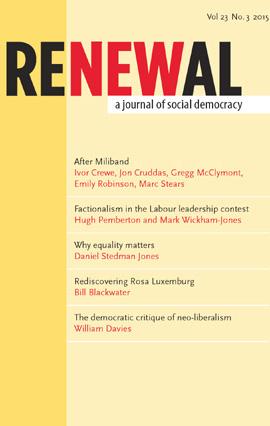
Factionalism in the Labour leadership contest
Renewal - Print ISSN 0968-5211 - Online ISSN
Volume 23 Number 3 (2015)
Factionalism in the Labour leadership contest
Hugh Pemberton, Mark Wickham-Jones
Abstract
What do nominations for the posts of Labour leader and deputy leader tell us about the state of the party? Do they suggest the existence of different ideological and political groupings within Labour? Or is there a more general and diffuse distribution to endorsements? Under the Collins reforms to the party’s structure, voted on and passed by a special conference in March 2014, those wishing to be candidates for either leadership post need to be publicly nominated by 15 percent of Labour Members of Parliament (MPs) in the House of Commons (Collins, 2014). Any viable contender for the post needed to mobilise sufficient support to meet that threshold. In the case of the two 2015 contests, with a Parliamentary Labour Party (PLP) of 232 MPs, the threshold was 35. By the time nominations closed for the leadership at 12.00 noon on Monday 15 June 2015, four candidates had made the final ballot: Andy Burnham, Yvette Cooper, Jeremy Corbyn, and Liz Kendall. When nominations closed two days later for the deputy leadership, five aspirants had made it: Ben Bradshaw, Stella Creasy, Angela Eagle, Caroline Flint, and Tom Watson.
To cite this article
Hugh Pemberton, Mark Wickham-Jones (2015) Factionalism in the Labour leadership contest, Renewal, 23(3)
